Strong Dipole-Quadrupole-Exciton Coupling Realized in a Gold Nanorod Dimer Placed on a Two-Dimensional Material
Abstract
1. Introduction
2. Materials and Methods
3. Results and Discussion
4. Conclusions
Author Contributions
Funding
Data Availability Statement
Conflicts of Interest
References
- Raimond, J.M.; Brune, M.; Haroche, S. Colloquium: Manipulating quantum entanglement with atoms and photons in a cavity. Rev. Mod. Phys. 2001, 73, 565–582. [Google Scholar] [CrossRef]
- Mabuchi, H.; Doherty, A.C. Cavity quantum electrodynamics: Coherence in context. Science 2002, 298, 1372–1377. [Google Scholar] [CrossRef] [PubMed]
- Kasprzak, J.; Richard, M.; Kundermann, S.; Baas, A.; Jeambrun, P.; Keeling, J.M.; Marchetti, F.M.; Szymanska, M.H.; Andre, R.; Staehli, J.L.; et al. Bose-Einstein condensation of exciton polaritons. Nature 2006, 443, 409–414. [Google Scholar] [CrossRef] [PubMed]
- Torma, P.; Barnes, W.L. Strong coupling between surface plasmon polaritons and emitters: A review. Rep. Prog. Phys. 2015, 78, 013901. [Google Scholar] [CrossRef]
- Sillanpaa, M.A.; Park, J.I.; Simmonds, R.W. Coherent quantum state storage and transfer between two phase qubits via a resonant cavity. Nature 2007, 449, 438–442. [Google Scholar] [CrossRef] [PubMed]
- Chen, W.; Beck, K.M.; Bucker, R.; Gullans, M.; Lukin, M.D.; Tanji-Suzuki, H.; Vuletic, V. All-optical switch and transistor gated by one stored photon. Science 2013, 341, 768–770. [Google Scholar] [CrossRef] [PubMed]
- Kena-Cohen, S.; Forrest, S.R. Room-temperature polariton lasing in an organic single-crystal microcavity. Nat. Photonics 2010, 4, 371–375. [Google Scholar] [CrossRef]
- Khitrova, G.; Gibbs, H.M.; Kira, M.; Koch, S.W.; Scherer, A. Vacuum Rabi splitting in semiconductors. Nat. Phys. 2006, 2, 81–90. [Google Scholar] [CrossRef]
- Smolka, S.; Wuester, W.; Haupt, F.; Faelt, S.; Wegscheider, W.; Imamoglu, A. Cavity quantum electrodynamics with many-body states of a two-dimensional electron gas. Science 2014, 346, 332–335. [Google Scholar] [CrossRef]
- Baranov, D.G.; Wersäll, M.; Cuadra, J.; Antosiewicz, T.J.; Shegai, T. Novel Nanostructures and Materials for Strong Light–Matter Interactions. ACS Photonics 2017, 5, 24–42. [Google Scholar] [CrossRef]
- Purcell, E.M.; Torrey, H.C.; Pound, R.V. Resonance Absorption by Nuclear Magnetic Moments in a Solid. Phys. Rev. 1946, 69, 37–38. [Google Scholar] [CrossRef]
- Liu, M.; Lee, T.W.; Gray, S.K.; Guyot-Sionnest, P.; Pelton, M. Excitation of dark plasmons in metal nanoparticles by a localized emitter. Phys. Rev. Lett. 2009, 102, 107401. [Google Scholar] [CrossRef]
- Sancho-Parramon, J.; Bosch, S. Dark modes and Fano resonances in plasmonic clusters excited by cylindrical vector beams. ACS Nano 2012, 6, 8415–8423. [Google Scholar] [CrossRef] [PubMed][Green Version]
- Huang, J.S.; Kern, J.; Geisler, P.; Weinmann, P.; Kamp, M.; Forchel, A.; Biagioni, P.; Hecht, B. Mode imaging and selection in strongly coupled nanoantennas. Nano Lett. 2010, 10, 2105–2110. [Google Scholar] [CrossRef] [PubMed]
- Zhou, W.; Odom, T.W. Tunable subradiant lattice plasmons by out-of-plane dipolar interactions. Nat. Nanotechnol. 2011, 6, 423–427. [Google Scholar] [CrossRef] [PubMed]
- Gao, Y.X.; Zhou, N.; Shi, Z.X.; Guo, X.; Tong, L.M. Dark dimer mode excitation and strong coupling with a nanorod dipole. Photonics Res. 2018, 6, 887–892. [Google Scholar] [CrossRef]
- Du, K.; Li, P.; Gao, K.; Wang, H.; Yang, Z.; Zhang, W.; Xiao, F.; Chua, S.J.; Mei, T. Strong Coupling between Dark Plasmon and Anapole Modes. J. Phys. Chem. Lett. 2019, 10, 4699–4705. [Google Scholar] [CrossRef]
- Ramasubramaniam, A. Large excitonic effects in monolayers of molybdenum and tungsten dichalcogenides. Phys. Rev. B 2012, 86, 115409. [Google Scholar] [CrossRef]
- Ye, Z.; Cao, T.; O’Brien, K.; Zhu, H.; Yin, X.; Wang, Y.; Louie, S.G.; Zhang, X. Probing excitonic dark states in single-layer tungsten disulphide. Nature 2014, 513, 214–218. [Google Scholar] [CrossRef]
- Li, Y.L.; Chernikov, A.; Zhang, X.; Rigosi, A.; Hill, H.M.; van der Zande, A.M.; Chenet, D.A.; Shih, E.M.; Hone, J.; Heinz, T.F. Measurement of the optical dielectric function of monolayer transition-metal dichalcogenides: MoS2, MoSe2, WS2, and WSe2. Phys. Rev. B 2014, 90, 205422. [Google Scholar] [CrossRef]
- Amani, M.; Taheri, P.; Addou, R.; Ahn, G.H.; Kiriya, D.; Lien, D.H.; Ager, J.W., 3rd; Wallace, R.M.; Javey, A. Recombination Kinetics and Effects of Superacid Treatment in Sulfur- and Selenium-Based Transition Metal Dichalcogenides. Nano Lett. 2016, 16, 2786–2791. [Google Scholar] [CrossRef]
- Huang, L.; Li, G.; Gurarslan, A.; Yu, Y.; Kirste, R.; Guo, W.; Zhao, J.; Collazo, R.; Sitar, Z.; Parsons, G.N.; et al. Atomically Thin MoS2 Narrowband and Broadband Light Superabsorbers. ACS Nano 2016, 10, 7493–7499. [Google Scholar] [CrossRef]
- Chernikov, A.; Berkelbach, T.C.; Hill, H.M.; Rigosi, A.; Li, Y.; Aslan, O.B.; Reichman, D.R.; Hybertsen, M.S.; Heinz, T.F. Exciton binding energy and nonhydrogenic Rydberg series in monolayer WS2. Phys. Rev. Lett. 2014, 113, 076802. [Google Scholar] [CrossRef]
- Liu, X.; Galfsky, T.; Sun, Z.; Xia, F.; Lin, E.-c.; Lee, Y.-H.; Kéna-Cohen, S.; Menon, V.M. Strong light–matter coupling in two-dimensional atomic crystals. Nat. Photonics 2014, 9, 30–34. [Google Scholar] [CrossRef]
- Bisht, A.; Cuadra, J.; Wersall, M.; Canales, A.; Antosiewicz, T.J.; Shegai, T. Collective Strong Light-Matter Coupling in Hierarchical Microcavity-Plasmon-Exciton Systems. Nano Lett. 2019, 19, 189–196. [Google Scholar] [CrossRef]
- Lee, B.; Liu, W.; Naylor, C.H.; Park, J.; Malek, S.C.; Berger, J.S.; Johnson, A.T.C.; Agarwal, R. Electrical Tuning of Exciton-Plasmon Polariton Coupling in Monolayer MoS2 Integrated with Plasmonic Nanoantenna Lattice. Nano Lett. 2017, 17, 4541–4547. [Google Scholar] [CrossRef]
- Qin, M.; Xiao, S.; Liu, W.; Ouyang, M.; Yu, T.; Wang, T.; Liao, Q. Strong coupling between excitons and magnetic dipole quasi-bound states in the continuum in WS2-TiO2 hybrid metasurfaces. Opt. Express 2021, 29, 18026–18036. [Google Scholar] [CrossRef]
- Wen, J.; Wang, H.; Wang, W.; Deng, Z.; Zhuang, C.; Zhang, Y.; Liu, F.; She, J.; Chen, J.; Chen, H.; et al. Room-Temperature Strong Light-Matter Interaction with Active Control in Single Plasmonic Nanorod Coupled with Two-Dimensional Atomic Crystals. Nano Lett. 2017, 17, 4689–4697. [Google Scholar] [CrossRef]
- Geisler, M.; Cui, X.M.; Wang, J.F.; Rindzevicius, T.; Gammelgaard, L.; Jessen, B.S.; Goncalves, P.A.D.; Todisco, F.; Boggild, P.; Boisen, A.; et al. Single-Crystalline Gold Nanodisks on WS2 Mono- and Multilayers for Strong Coupling at Room Temperature. ACS Photonics 2019, 6, 994–1001. [Google Scholar] [CrossRef]
- Cuadra, J.; Baranov, D.G.; Wersall, M.; Verre, R.; Antosiewicz, T.J.; Shegai, T. Observation of Tunable Charged Exciton Polaritons in Hybrid Monolayer WS2-Plasmonic Nanoantenna System. Nano Lett. 2018, 18, 1777–1785. [Google Scholar] [CrossRef]
- Munkhbat, B.; Baranov, D.G.; Bisht, A.; Hoque, M.A.; Karpiak, B.; Dash, S.P.; Shegai, T. Electrical Control of Hybrid Monolayer Tungsten Disulfide-Plasmonic Nanoantenna Light-Matter States at Cryogenic and Room Temperatures. ACS Nano 2020, 14, 1196–1206. [Google Scholar] [CrossRef]
- Zheng, D.; Zhang, S.; Deng, Q.; Kang, M.; Nordlander, P.; Xu, H. Manipulating Coherent Plasmon-Exciton Interaction in a Single Silver Nanorod on Monolayer WSe2. Nano Lett. 2017, 17, 3809–3814. [Google Scholar] [CrossRef]
- Lepeshov, S.; Wang, M.; Krasnok, A.; Kotov, O.; Zhang, T.; Liu, H.; Jiang, T.; Korgel, B.; Terrones, M.; Zheng, Y.; et al. Tunable Resonance Coupling in Single Si Nanoparticle-Monolayer WS2 Structures. ACS Appl. Mater. Interfaces 2018, 10, 16690–16697. [Google Scholar] [CrossRef]
- Yan, X.; Wei, H. Strong plasmon-exciton coupling between lithographically defined single metal nanoparticles and monolayer WSe2. Nanoscale 2020, 12, 9708–9716. [Google Scholar] [CrossRef]
- Han, X.B.; Wang, K.; Xing, X.Y.; Wang, M.Y.; Lu, P.X. Rabi Splitting in a Plasmonic Nanocavity Coupled to a WS2 Monolayer at Room Temperature. ACS Photonics 2018, 5, 3970–3976. [Google Scholar] [CrossRef]
- Kleemann, M.E.; Chikkaraddy, R.; Alexeev, E.M.; Kos, D.; Carnegie, C.; Deacon, W.; de Pury, A.C.; Grosse, C.; de Nijs, B.; Mertens, J.; et al. Strong-coupling of WSe2 in ultra-compact plasmonic nanocavities at room temperature. Nat. Commun. 2017, 8, 1296. [Google Scholar] [CrossRef] [PubMed]
- Hou, S.; Tobing, L.Y.M.; Wang, X.; Xie, Z.; Yu, J.; Zhou, J.; Zhang, D.; Dang, C.; Coquet, P.; Tay, B.K.; et al. Manipulating Coherent Light–Matter Interaction: Continuous Transition between Strong Coupling and Weak Coupling in MoS2 Monolayer Coupled with Plasmonic Nanocavities. Adv. Opt. Mater. 2019, 7, 1900857. [Google Scholar] [CrossRef]
- Huang, H.X.; Deng, F.; Xiang, J.; Li, S.L.; Lan, S. Plasmon-exciton coupling in dielectric-metal hybrid nanocavities with an embedded two-dimensional material. Appl. Surf. Sci. 2021, 542, 148660. [Google Scholar] [CrossRef]
- Deng, F.; Liu, H.; Xu, L.; Lan, S.; Miroshnichenko, A.E. Strong Exciton–Plasmon Coupling in a WS2 Monolayer on Au Film Hybrid Structures Mediated by Liquid Ga Nanoparticles. Laser Photonics Rev. 2020, 14, 1900420. [Google Scholar] [CrossRef]
- Xie, P.; Li, D.M.; Chen, Y.X.; Chang, P.J.; Zhang, H.; Yi, J.M.; Wang, W. Enhanced coherent interaction between monolayer WS2 and film-coupled nanocube open cavity with suppressed incoherent damping pathway. Phys. Rev. B 2020, 102, 115430. [Google Scholar] [CrossRef]
- Verre, R.; Baranov, D.G.; Munkhbat, B.; Cuadra, J.; Kall, M.; Shegai, T. Transition metal dichalcogenide nanodisks as high-index dielectric Mie nanoresonators. Nat. Nanotechnol. 2019, 14, 679–683. [Google Scholar] [CrossRef] [PubMed]
- Rousseaux, B.; Baranov, D.G.; Antosiewicz, T.J.; Shegai, T.; Johansson, G. Strong coupling as an interplay of quantum emitter hybridization with plasmonic dark and bright modes. Phys. Rev. Res. 2020, 2, 033056. [Google Scholar] [CrossRef]
- Li, B.W.; Zu, S.; Zhang, Z.P.; Zheng, L.H.; Jiang, Q.; Du, B.W.; Luo, Y.; Gong, Y.J.; Zhang, Y.F.; Lin, F.; et al. Large Rabi splitting obtained in Ag-WS2 strong-coupling heterostructure with optical microcavity at room temperature. Opto Electron. Adv. 2019, 2, 19000801–19000809. [Google Scholar] [CrossRef]
- Zhang, H.; Abhiraman, B.; Zhang, Q.; Miao, J.; Jo, K.; Roccasecca, S.; Knight, M.W.; Davoyan, A.R.; Jariwala, D. Hybrid exciton-plasmon-polaritons in van der Waals semiconductor gratings. Nat. Commun. 2020, 11, 3552. [Google Scholar] [CrossRef]
- As’ham, K.; Al-Ani, I.; Huang, L.; Miroshnichenko, A.E.; Hattori, H.T. Boosting Strong Coupling in a Hybrid WSe2 Monolayer–Anapole–Plasmon System. ACS Photonics 2021, 8, 489–496. [Google Scholar] [CrossRef]
- Johnson, P.B.; Christy, R.W. Optical Constants of the Noble Metals. Phys. Rev. B 1972, 6, 4370–4379. [Google Scholar] [CrossRef]
- Zhang, S.; Chen, L.; Huang, Y.; Xu, H. Reduced linewidth multipolar plasmon resonances in metal nanorods and related applications. Nanoscale 2013, 5, 6985–6991. [Google Scholar] [CrossRef] [PubMed]
- Huang, L.; Krasnok, A.; Alu, A.; Yu, Y.; Neshev, D.; Miroshnichenko, A.E. Enhanced Light-Matter Interaction in Two-Dimensional Transition Metal Dichalcogenides. arXiv 2021, arXiv:2103.11064. [Google Scholar]
- Hopfield, J.J. Theory of the Contribution of Excitons to the Complex Dielectric Constant of Crystals. Phys. Rev. 1958, 112, 1555–1567. [Google Scholar] [CrossRef]
- Zengin, G.; Wersall, M.; Nilsson, S.; Antosiewicz, T.J.; Kall, M.; Shegai, T. Realizing Strong Light-Matter Interactions between Single-Nanoparticle Plasmons and Molecular Excitons at Ambient Conditions. Phys. Rev. Lett. 2015, 114, 157401. [Google Scholar] [CrossRef] [PubMed]
- Savasta, S.; Saija, R.; Ridolfo, A.; Di Stefano, O.; Denti, P.; Borghese, F. Nanopolaritons: Vacuum Rabi splitting with a single quantum dot in the center of a dimer nanoantenna. ACS Nano 2010, 4, 6369–6376. [Google Scholar] [CrossRef] [PubMed]
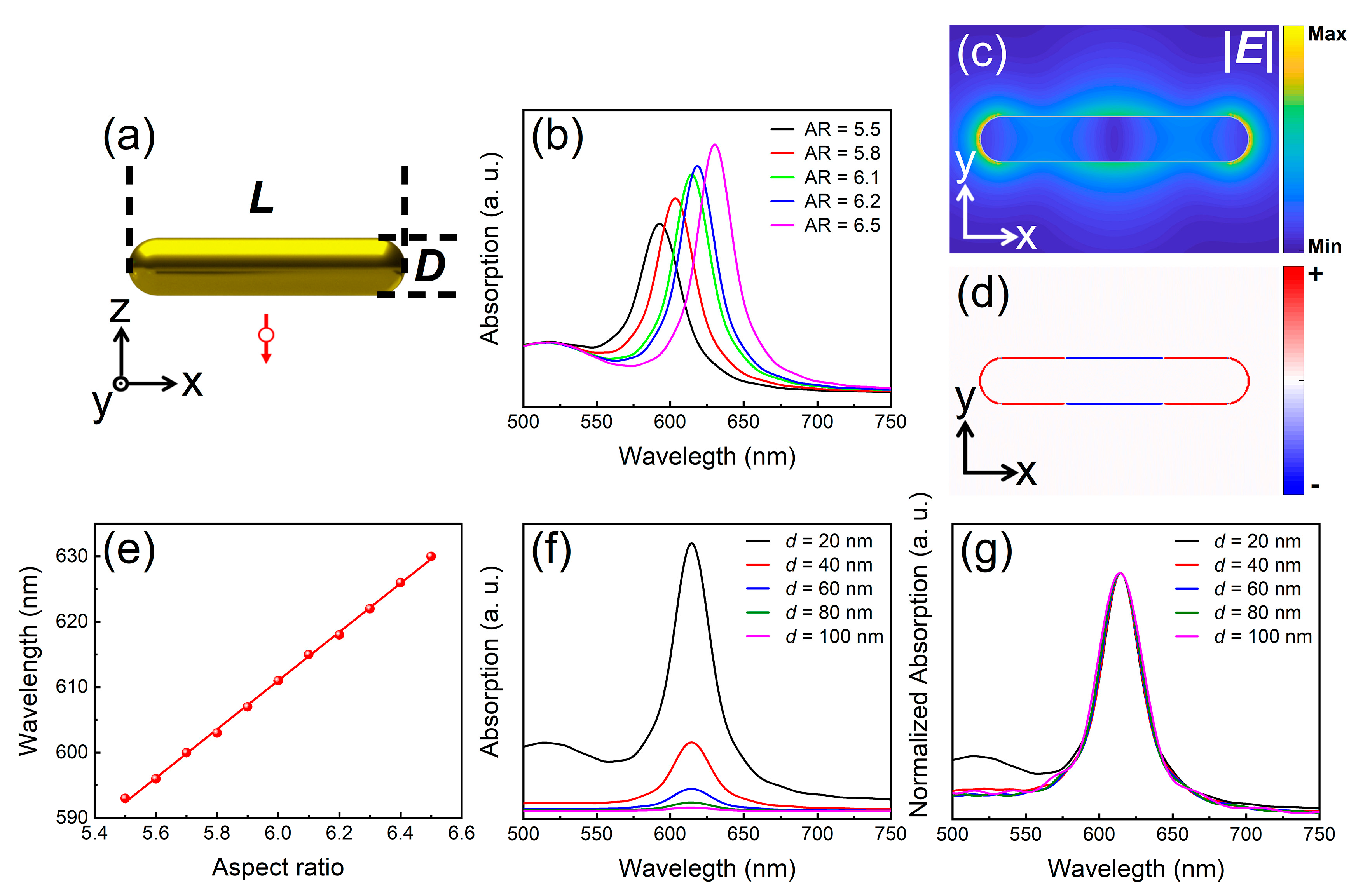
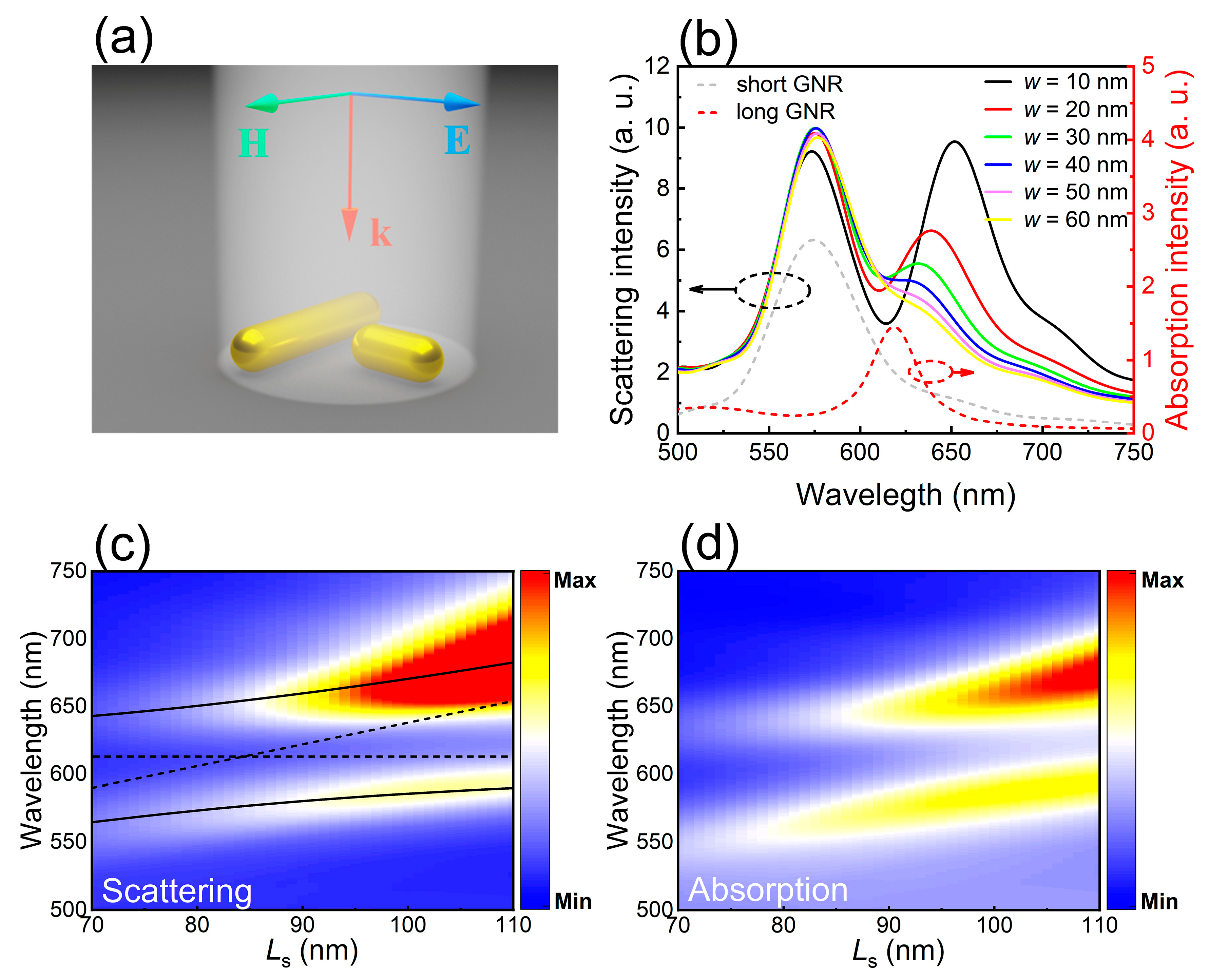

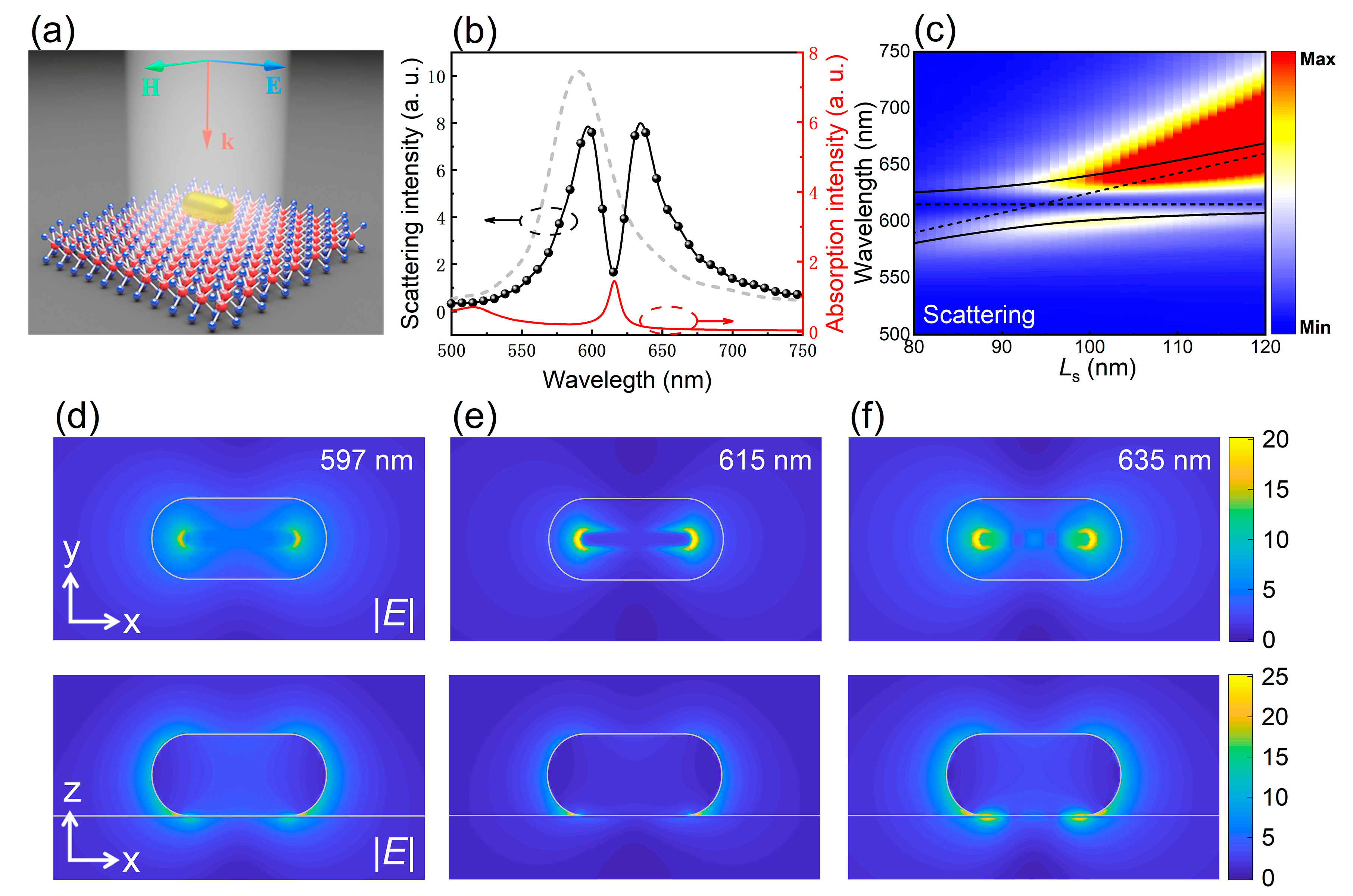
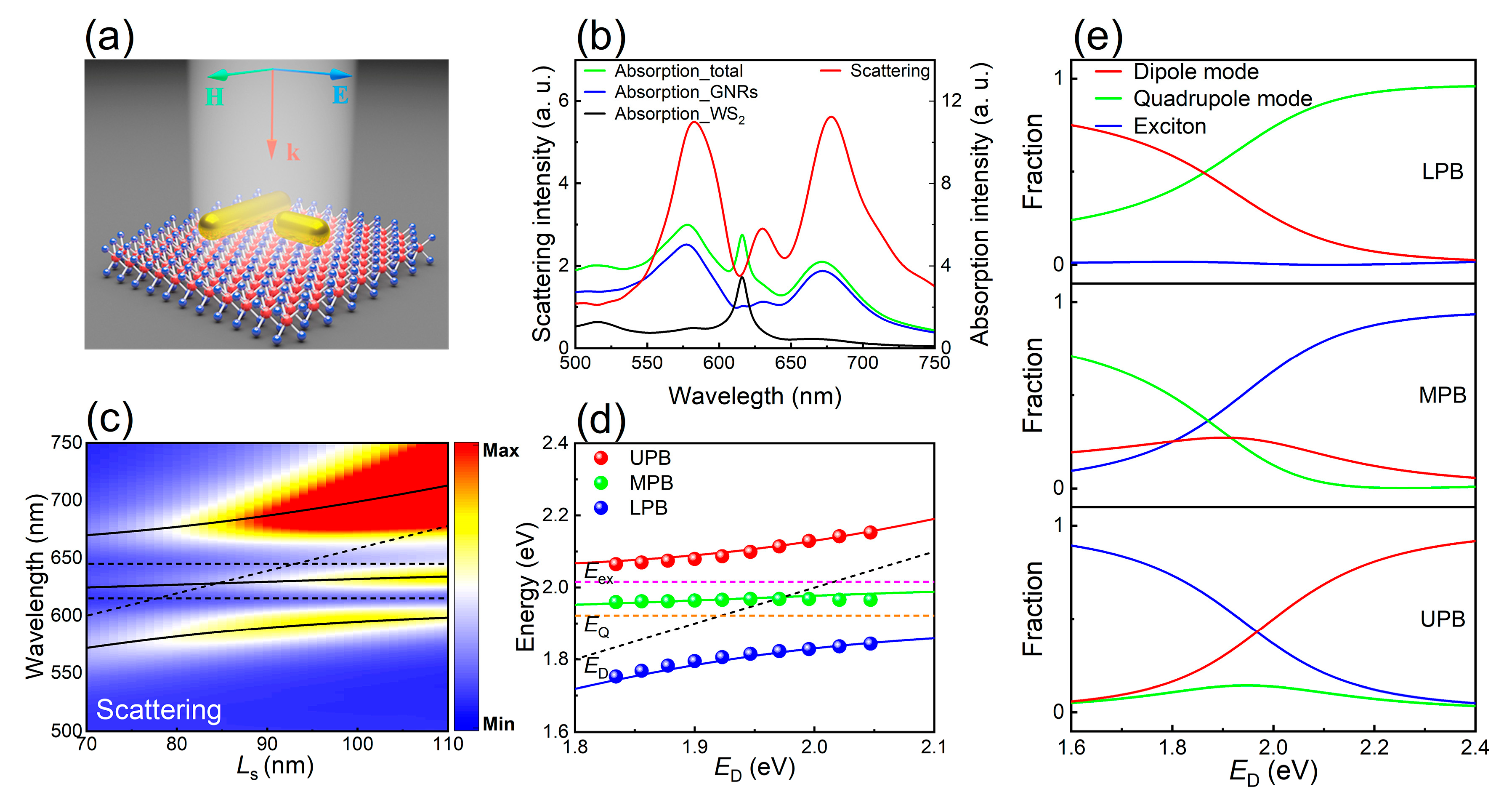

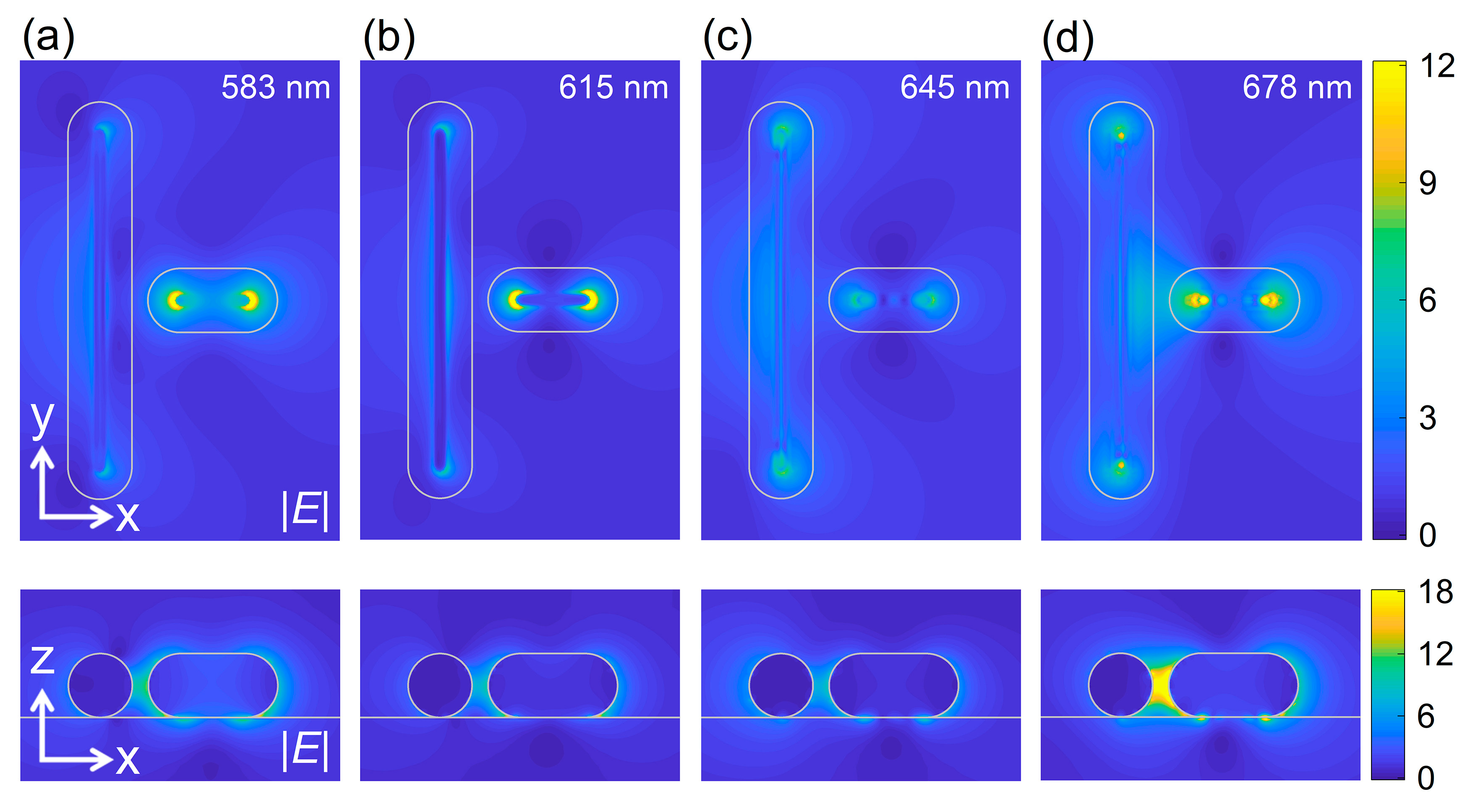
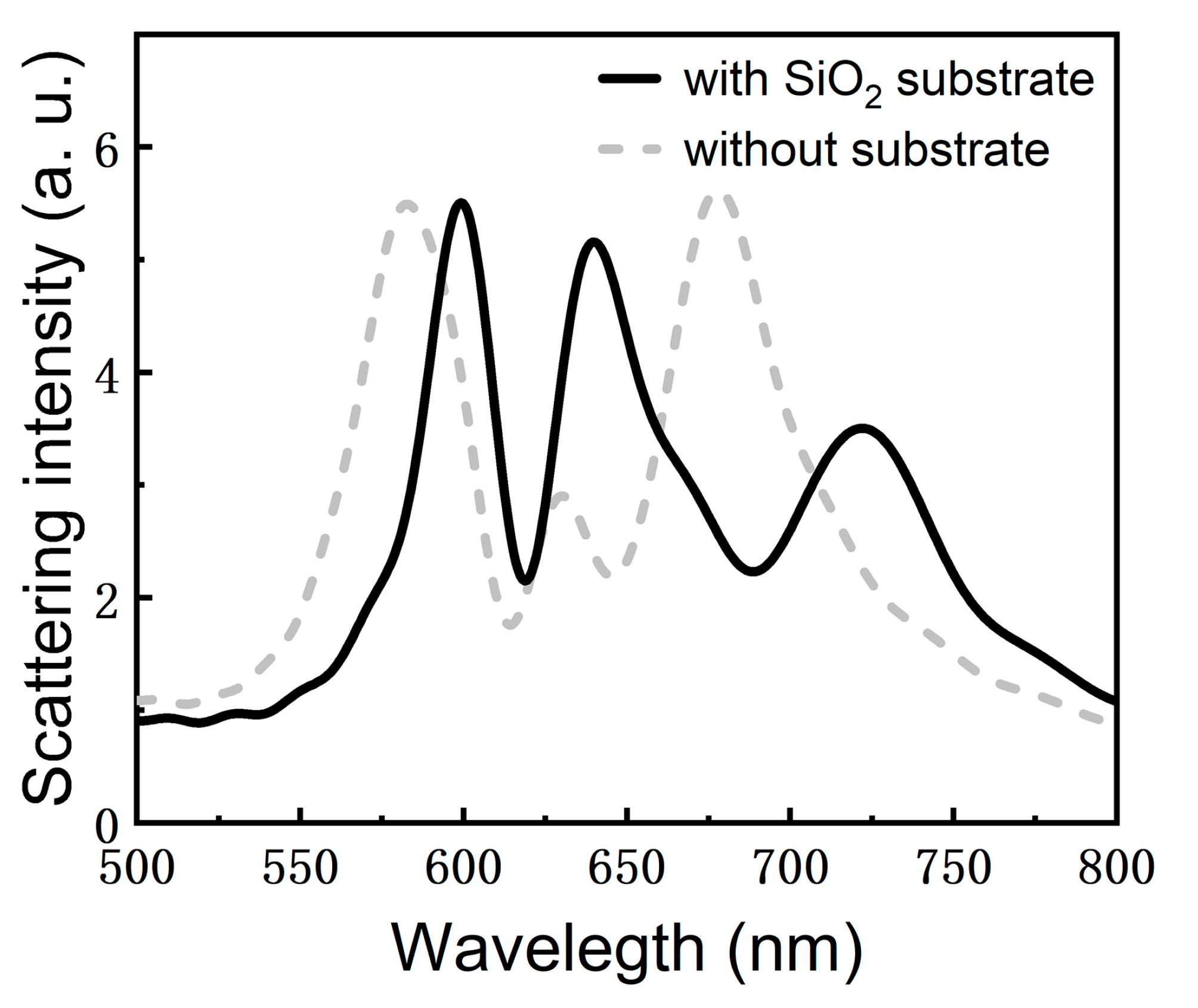
Publisher’s Note: MDPI stays neutral with regard to jurisdictional claims in published maps and institutional affiliations. |
© 2021 by the authors. Licensee MDPI, Basel, Switzerland. This article is an open access article distributed under the terms and conditions of the Creative Commons Attribution (CC BY) license (https://creativecommons.org/licenses/by/4.0/).
Share and Cite
Pang, H.; Huang, H.; Zhou, L.; Mao, Y.; Deng, F.; Lan, S. Strong Dipole-Quadrupole-Exciton Coupling Realized in a Gold Nanorod Dimer Placed on a Two-Dimensional Material. Nanomaterials 2021, 11, 1619. https://doi.org/10.3390/nano11061619
Pang H, Huang H, Zhou L, Mao Y, Deng F, Lan S. Strong Dipole-Quadrupole-Exciton Coupling Realized in a Gold Nanorod Dimer Placed on a Two-Dimensional Material. Nanomaterials. 2021; 11(6):1619. https://doi.org/10.3390/nano11061619
Chicago/Turabian StylePang, Huajian, Hongxin Huang, Lidan Zhou, Yuheng Mao, Fu Deng, and Sheng Lan. 2021. "Strong Dipole-Quadrupole-Exciton Coupling Realized in a Gold Nanorod Dimer Placed on a Two-Dimensional Material" Nanomaterials 11, no. 6: 1619. https://doi.org/10.3390/nano11061619
APA StylePang, H., Huang, H., Zhou, L., Mao, Y., Deng, F., & Lan, S. (2021). Strong Dipole-Quadrupole-Exciton Coupling Realized in a Gold Nanorod Dimer Placed on a Two-Dimensional Material. Nanomaterials, 11(6), 1619. https://doi.org/10.3390/nano11061619





